Complete Guide to World War I Memorial in Washington DC, including things to do, history, nearby lodging and camping, directions, and so much more.
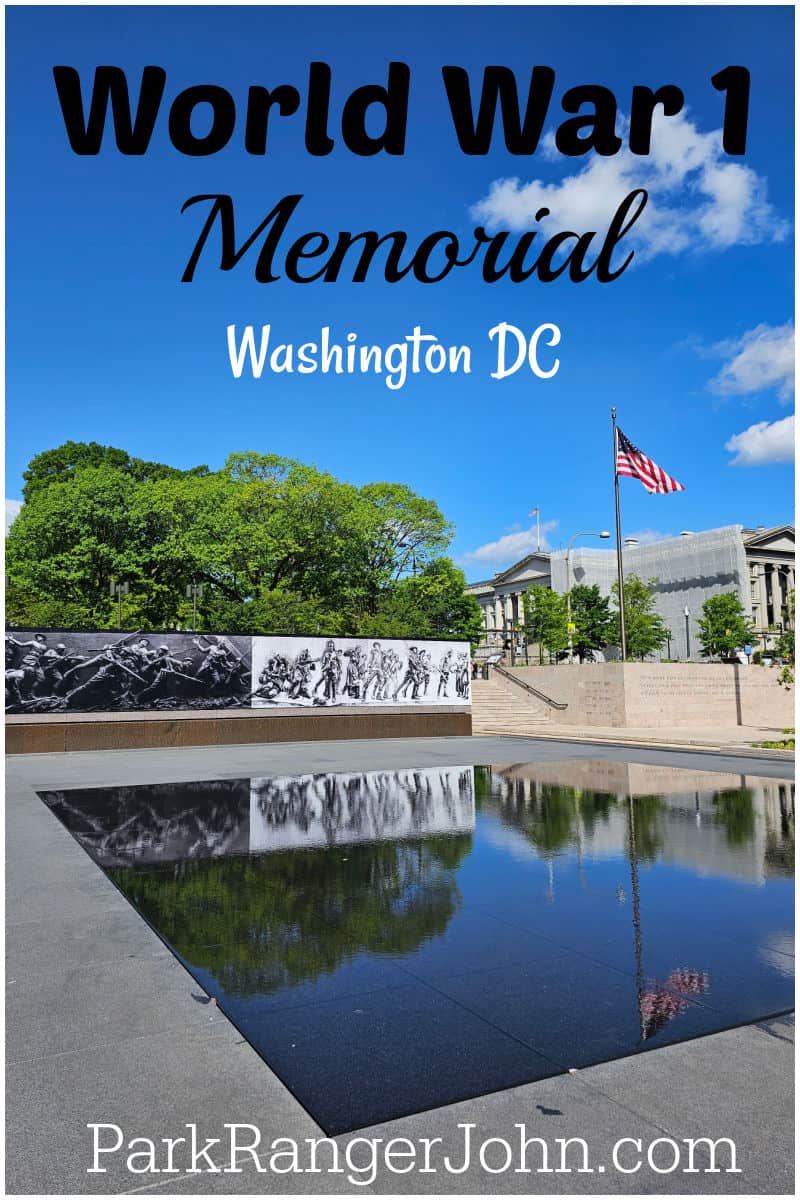
World War I Memorial
The World War 1 Memorial is located in Washington DC right across the street from the US Department of Treasury and the White House and President's Park. It is dedicated to the 4.7 million Americans who served in this war.
About World War I Memorial
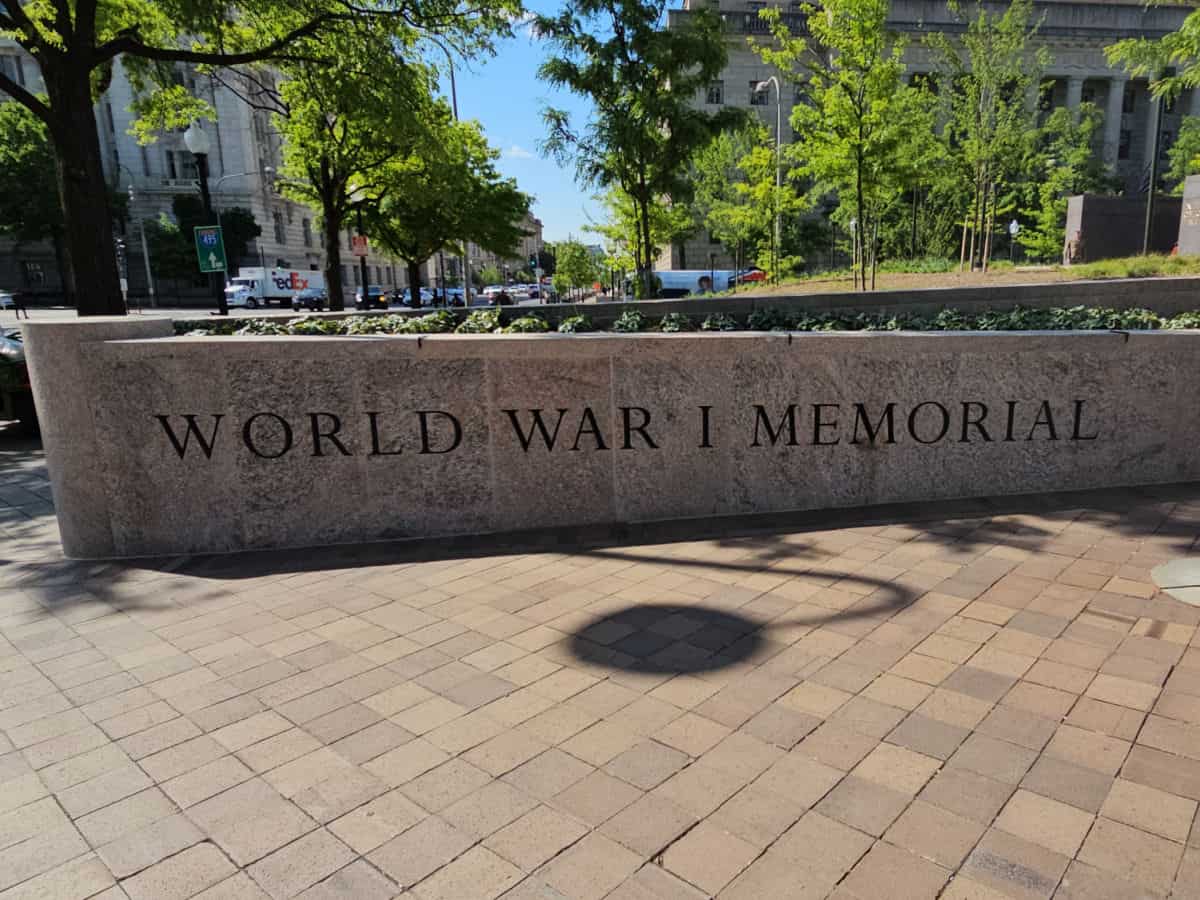
The World War 1 Memorial is open 24 hours a day, 365 days a year. There are several key features to see at the memorial including the Pershing Memorial, The Belvedere, A Soldiers Journey sculpture, interpretative Panels, and five different Memorial Inscriptions including "The Every Man" from President Woodrow Wilson.
Is World War I Memorial worth visiting?
Absolutely! Visiting the World War I Memorial in Washington, D.C. is an experience that's well worth your time. Stepping onto the grounds of the memorial, you can feel the weight of history and the echo of stories from a century ago.
This isn't just a monument - it's a tribute to the bravery and sacrifice of over 4 million Americans who served during World War I. Each detail of the memorial, from its architectural design to the intricate inscriptions, weaves together a tale of our nation's role in the Great War.
History of World War I Memorial
The World War I National Memorial commemorates and honors the 4.7 million American men and women who served in the Great War. Initially, America stayed out of the war that began in Europe in July 1914. America entered the war in 1917, and by November 1918, over 100,000 American servicemen and women had been killed.
The Great War, or World War I, began in Europe in 1914 with the assassination of the heir to the Austro-Hungarian Empire, Archduke Franz Ferdinand. War broke out between the Central Powers, which included Germany, Austria-Hungary, the Ottoman Empire (Turkey), and Bulgaria, and the Allied Powers: Great Britain, France, Italy, Russia, and finally, the United States of America.
When America entered the war in 1917, World War I was being fought on many fronts that stretched as far as the Middle East. In Europe, the war had become stagnant trench warfare fought in trenches stretching across Europe. American involvement helped to push the Central Powers back from Allied territory.
America Enters World War I
When war erupted on the European continent in 1914, American President Woodrow Wilson, was hesitant to involve America in the conflict. Wilson adopted a policy of noninvolvement in the war, and the American people supported him. America remained neutral, continuing to trade with the Allied and Central Powers.
American attitudes toward the war began to change in 1915 when German submarines began operating in the seas around Europe. On May 7th, 1915, the Lusitania, a British ocean liner that had set sail from New York with 128 Americans aboard, was torpedoed by a German submarine in the Celtic Sea, killing all aboard.
The final straw for Woodrow Wilson came in 1917 when Germany threatened an alliance with Mexico. Wilson received word that Germany had offered to aid Mexico in retaking territory the Mexicans had lost in 1848.
Wilson had no choice but to ask Congress for a formal declaration of war. America declared war on Germany on April 6th, 1917.
American Involvement in World War I
When America entered the conflict, the Central Powers and the Allies found themselves low on morale and men. The Russians had withdrawn from the war because of the 1917 revolution, which meant the Allies lost many soldiers.
The war had taken the form of stagnant trench warfare that resulted in long and bloody battles with little to be gained by either side. The first American soldiers arrived in France in June 1917, under the command of General John J. Pershing, in whose honor the original World War I monument was named.
Despite the arrival of Pershing and his troops in 1917, it would be a year before the full force of the American reinforcements would arrive in Europe. In the Spring of 1918, the Germans launched a massive offensive to try and cripple the Allies before the American's arrival.
The Spring offensive ultimately failed. American troops arrived and deployed to the Western Front, where they began the daunting and costly task of retaking Allied territory.
The American troops fought in the trenches at the Somme and Flanders Fields, fighting relentlessly for days to push the Germans out. American involvement in pivotal battles during World War I have become military legends.
During a campaign known as the 100 days offensive, half a million American servicemen helped end World War I. It was during this offensive that the largest battle in American history took place on European soil on September 26th, 1918. The battle resulted in over 26,000 American lives lost. Two months later, the Great War was over.
Lest We Forget
With the help of American servicemen and women, the Allies defeated the Central Powers. World War I officially ended on November 11th and 11:00 am 1918.
Over 100,000 American lives were lost from 1917 until 1918 which, at the time, made World War I the second deadliest war in American history. The outbreak of World War II just over two decades later would surpass the death toll of the Great War.
The World War I Memorial was constructed to honor the 4.7 million men and women who served in the United States Armed forces at home or in Europe. The memorial is built in Pershing Park, which was dedicated in 1981 to honor the American Expeditionary Forces, the first Americans to arrive to help the Allies in the war.
The World War I memorial was added to the park and was officially opened in April 2021 to honor not just the members of the AEF, but all those who served and died during the War to End All Wars.
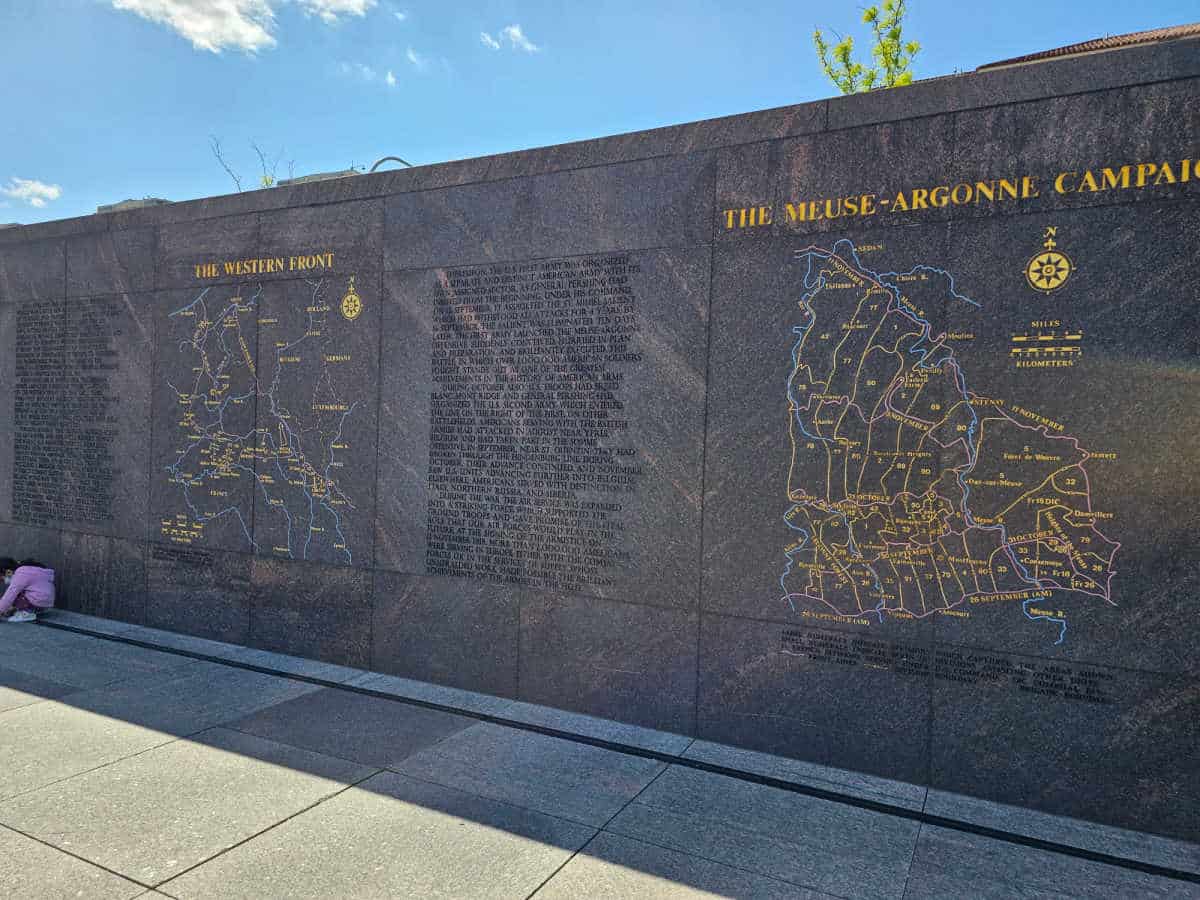
Things to know before your visit to World War I Memorial
Entrance fee
$0.00 - There is no entrance fee to visit the park.
Learn more about National Park Passes for parks that have an entrance fee.
$80.00 - For the America the Beautiful/National Park Pass. The pass covers entrance fees to all US National Park Sites and over 2,000 Federal Recreation Fee Sites for an entire year and covers everyone in the car for per-vehicle sites and up to 4 adults for per-person sites.

Buy your pass at this link, and REI will donate 10% of pass proceeds to the National Forest Foundation, National Park Foundation, and the U.S. Endowment for Forestry & Communities.
National Park Free Entrance Days -Mark your calendars with the five free entrance days the National Park Service offers annually.
Time Zone
Eastern Time Zone
Pets
You can certainly bring your furry friends along when visiting the parks, including the World War I Memorial. However, it's essential to keep them on a leash at all times to ensure everyone's safety and enjoyment.
While pets are welcome in the outdoor areas, please note that they are not permitted inside any of the museums or institutions.
Cell Service
Cell Service should be great in Washington DC
Park Hours
The WWI Memorial is open 24 hours a day.
Wi-Fi
There is no public Wi-Fi available at the memorial park. However, there are public Wi-Fi available in some parts of National Mall and area sites.
Insect Repellent
Insect repellent is always a great idea when outdoors, especially if you are around any body of water.
We use Permethrin Spray on our clothes before our park trips.
Water Bottle
Make sure to bring your own water bottle and plenty of water with you. Plastic water bottles are not sold in the park.
Parking
Parking can be difficult to find. Parking is available along Ohio Drive, SW between the Lincoln and Thomas Jefferson Memorials.
There are 1,200 metered parking spaces through the National Mall area provided by the National Park Service.
These parking pay stations accept debit and credit cards. They do not accept cash or coins.
Payment can also be made via the Parkmobile app or website.
Metered parking can be found:
- Constitution Avenue NW between 15th Street NW and 23rd Street NW
- Parkway Drive SW
- Ohio Drive SW in West Potomac Park (between Independence Ave and Inlet Bridge)
- West Basin Drive SW (entire length, between Ohio Drive and Independence Avenue)
- Tidal Basin parking lot (paddle boats)
- Madison Drive NW
- Jefferson Drive SW
- Lots A, B, and C on Ohio Drive SW (East Potomac Park)
- Lot on Buckeye Drive (adjacent to tennis courts)
There are 300 free parking spaces at Hains Point within East Potomac Park.
Accessible parking spaces are available for vehicles displaying disability parking permits, placards, and vehicle tags. In the areas where a parking fee is being charged visitors will need to pay for the accessible parking spaces.
Motorcycles can park in lots A, B, C areas off of Ohio Drive.
Food/Restaurants
There are no restaurants within the park.
Gas
There are no gas stations within the park.
Drones
Drones are not permitted within National Park Sites.
National Park Passport Stamps
National Park Passport stamps can be found in the visitor center.
We like to use these circle stickers for park stamps so we don't have to bring our passport book with us on every trip.
The National Park Passport Book program is a great way to document all of the parks you have visitied.
You can get Passport Stickers and Annual Stamp Sets to help enhance your Passport Book.
Electric Vehicle Charging
There are 500 public EV Charging Stations in Washington DC (Level 2 and Level 3)
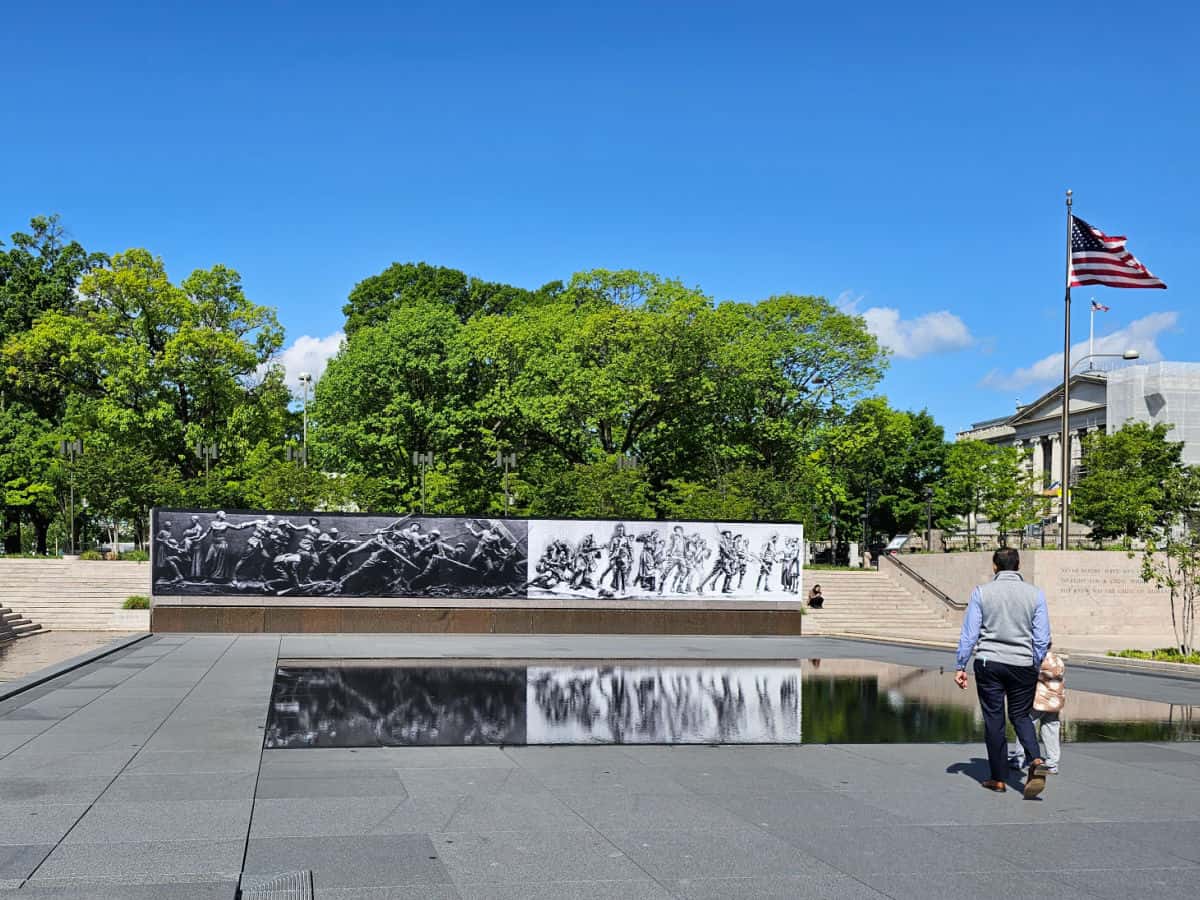
Details about World War I Memorial
Size - 1.76 acres
Check out how the park compares to other National Parks by Size.
Date Established
The World War I Memorial in Washington, D.C., was officially dedicated on April 16, 2021. However, the memorial's journey began much earlier. The site was originally known as Pershing Park, named after General John J. Pershing who led the American Expeditionary Forces in World War I.
Visitation
In 2022, World War I Memorial had 848,634 park visitors.
In 2021, World War I Memorial had 573,088 park visitors.
Learn more about the most visited and least visited National Parks in the US
National Park Address
1493 Pennsylvania Avenue NW,
Washington, DC 20004
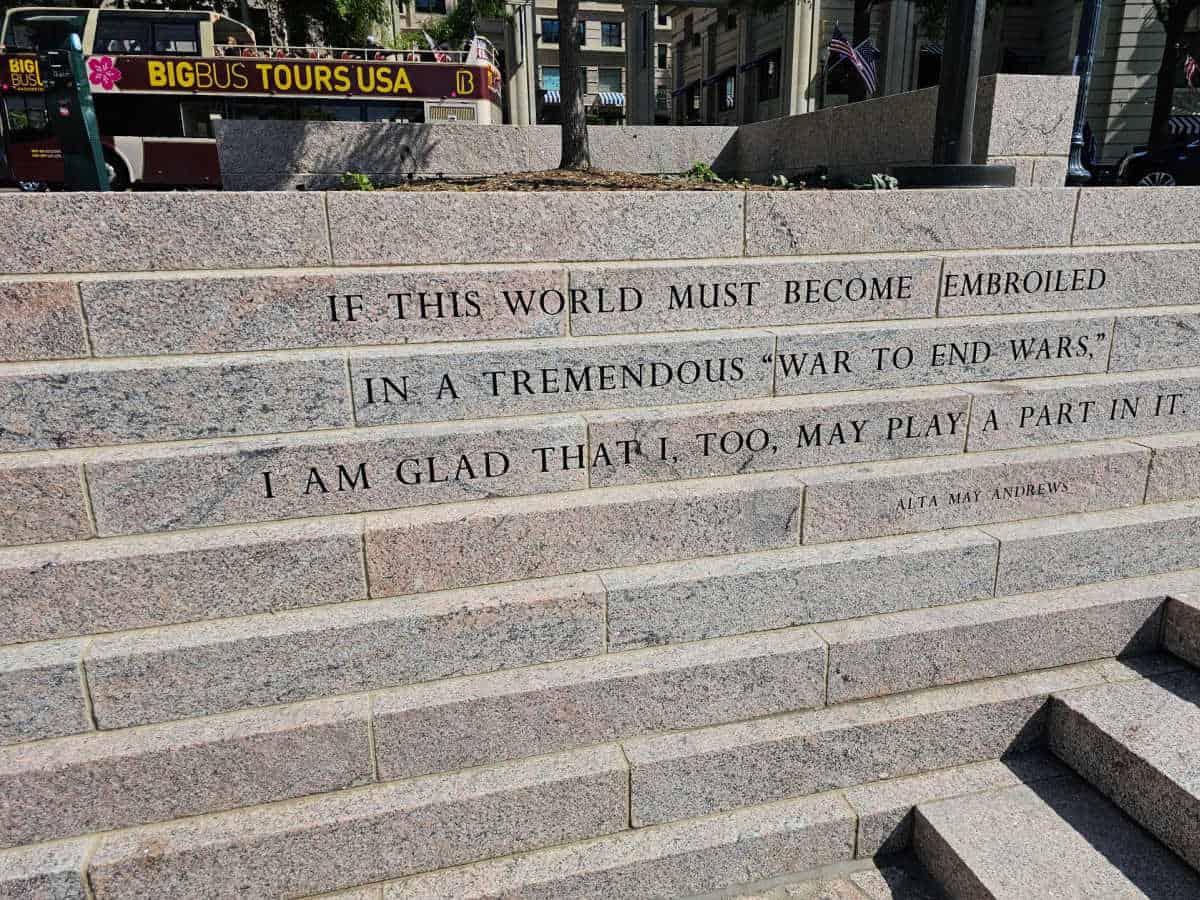
Where is World War I Memorial?
The World War I Memorial is located in Washington, D.C., the capital city of the United States. It's situated on the eastern end of the National Mall, near the White House, and specifically at the intersection of 17th Street NW and Constitution Avenue NW. The site is not far from the Washington Monument and the Lincoln Memorial, making it an accessible part of a larger tour of the city's historic landmarks.
Estimated distance from major cities nearby
- Baltimore, MD - 41 miles
- Philadelphia, PA - 142 miles
- Norfolk, VA - 107 miles
- Virginia Beach, VA - 64 miles
- Pittsburgh, PA - 245 miles
- Newark, NJ - 219 miles
- Jersey City, NJ - 224 miles
- New York, NY - 227 miles
Estimated Distance from nearby National Park
Shenandoah National Park - 70 miles
New River Gorge National Park - 155 miles
Great Smoky Mountains National Park - 375 miles
Cuyahoga Valley National Park - 350 miles
Mammoth Cave National Park - 662 miles
Congaree National Park - 482 miles
Where is the National Park Visitor Center?
One of the main visitor centers in the area is the National Park Service Information, located at the National Mall. This center provides information about all of the sites within the National Mall and Memorial Parks area, which includes the World War I Memorial.
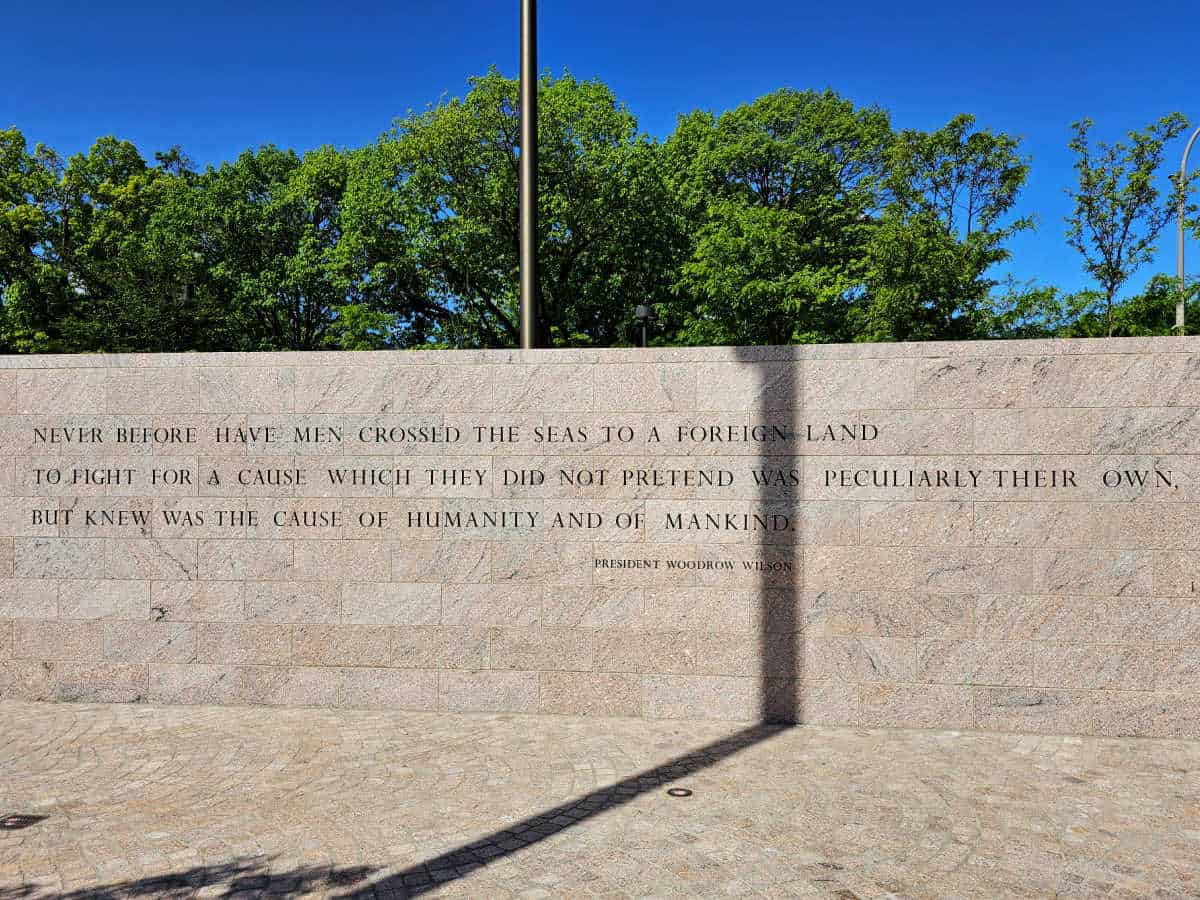
Getting to World War I Memorial
Closest Airports
Ronald Reagan Washington National Airport
Washington Dulles International Airport
Baltimore Washington International Thurgood Marshall Airport
Driving Directions
- Interstate 395 provides access to the Mall from the South.
- Interstate 495, New York Avenue, Rock Creek and Potomac Parkway, George Washington Memorial Parkway, and the Cabin John Parkway provide access from the North.
- Interstate 66, U.S. Routes 50 and 29 provide access from the West.
- U.S. Routes 50, 1, and 4 provide access from the East.
Public Transportation
The DC Metro system, known as the Metro, offers easy access. From the Blue, Orange, or Silver lines, exit at the Federal Triangle station. If you're on the Red line, use Metro Center. Both stations are near the World War I Memorial.
Alternatively, for a more active route, use the Capital Bikeshare service. It offers over 4,500 bikes across the region with several stations near the National Mall. One such station is at 15th Street NW and Pennsylvania Avenue NW, directly across from the World War I Memorial.
On Off-Bus Tour
One of our favorite ways to explore Washington DC is on an On Off Bus Tour.
This is the perfect way to let someone else do the driving. Plus, you can sit on the top deck and get epic pictures while riding around the city.
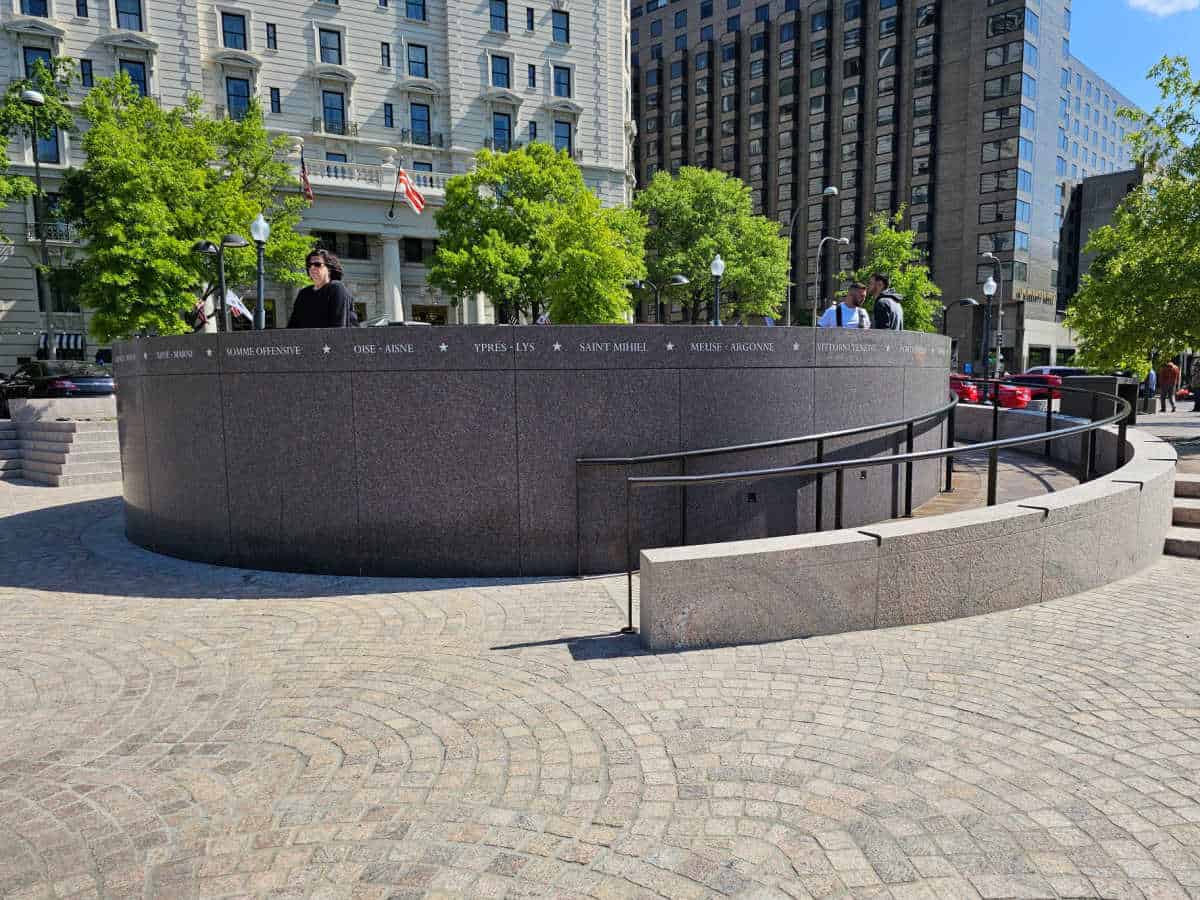
Best time to visit
Choosing the perfect time to explore the World War I Memorial can enhance your experience. Generally, the most favorable time to visit Washington D.C. is in June or between mid-August and early October.
During these periods, the weather is typically pleasant - not too hot, not too cold, and less humid. It's the perfect climate for leisurely strolls around the Memorial, allowing you to fully appreciate its historical significance and architectural beauty.
Whether you're capturing photographs, participating in the Junior Ranger Program, or simply soaking in the atmosphere, these periods promise comfortable weather for a memorable visit to the World War I Memorial.
Weather and Seasons
Summers are warm and muggy in Washington DC while winters are super cold and snowy.
The hottest weather is from May 30 to September 16th when the average daily temperature is above 79 degrees.
The coldest weather is from December 1st to March 4th with an average temperature below 52 degrees.
The coldest month is January. May gets the most rain with an average of 3.5 inches.
February gets the most snow with an average of 5.4 inches.
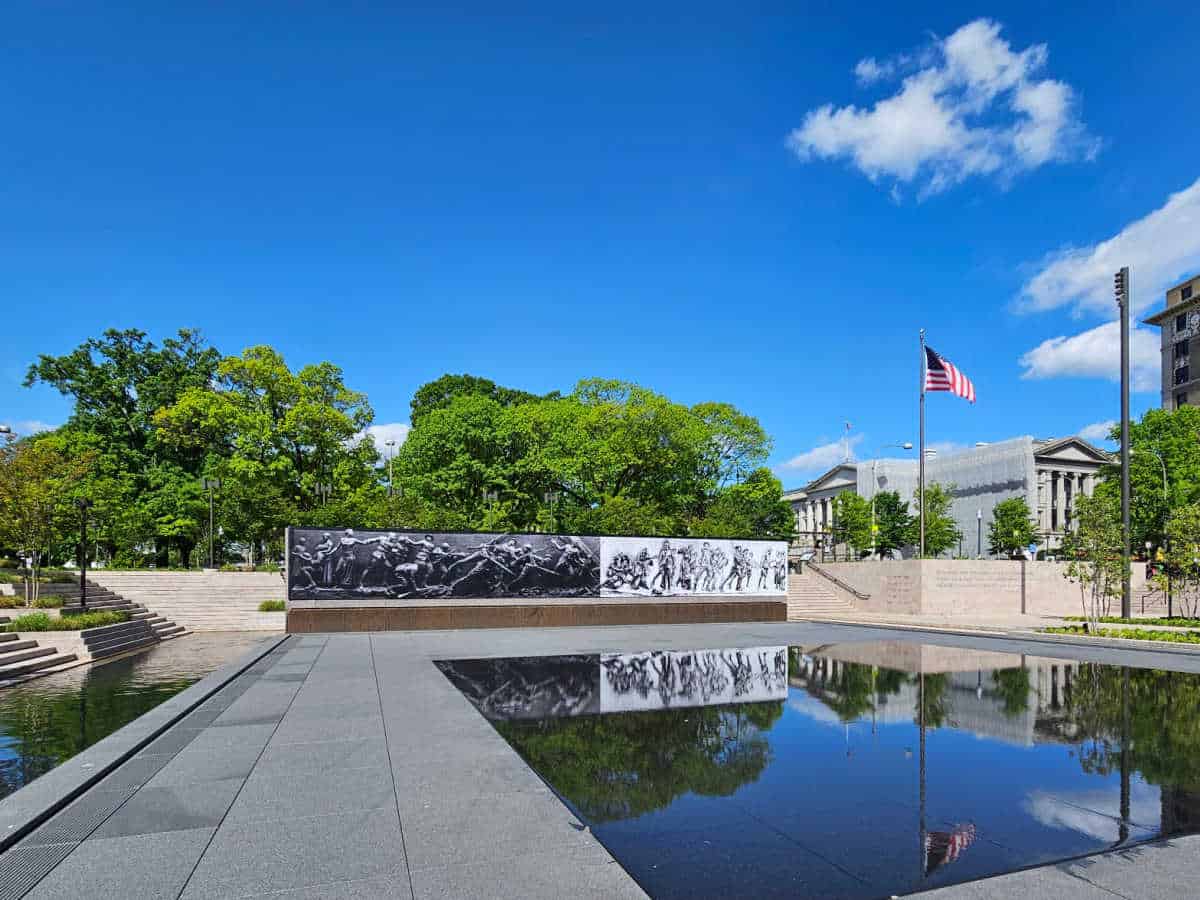
Best Things to do
World War 1 Memorial
Step into a significant slice of American history at the World War I Memorial in Washington D.C. This compelling monument is a tribute to the countless heroes who braved the trials of the Great War.
The memorial's impressive architecture stands as a symbol of resilience, while the intricately carved inscriptions narrate stories of courage and unity. As you walk through this solemn space, you'll be moved by the profound respect and gratitude that resonates throughout.
Capture the memorial's grandeur against the backdrop of the D.C. skyline - a visual testament to America's enduring spirit. Visiting the World War I Memorial offers a deep connection to the past, making it a truly enriching experience.
Junior Ranger Program
The Junior Ranger Program is an interactive program that combines fun and learning, helping kids explore the Memorial and its history. Upon completion, they'll receive a Junior Ranger badge, symbolizing their role in protecting America's national parks.
Guided Tours
A great way to visit the Memorial and other park sites is on a guided tour.
This is the perfect way to learn more about the sites without having to worry about driving and parking in town.
DC Monuments and Memorial Tour - This tour visits the Capitol Building, White House, Lincoln Memorial, World War II Memorial, and more.
National Mall and Memorials Guided Walking Tour - This 2.5-hour tour guides you through the top sites on the National Mall.
Monuments by Moonlight Nighttime Trolley Tour - Experience the sights of Washington D.C. by night on a guided trolley tour of the city's most popular monuments. Along the way, learn about the fascinating history of the nation's capital.
African American History Tour - Go back in time to some of the most iconic moments of the civil rights movement, with a fascinating African American history tour of Washington, DC.
Big Bus Hop On Hop Off Tour - Explore Washington, DC's famous and historic landmarks with a 24-, 48-, or 72-hour ticket. See the city at your own pace with unlimited access to two hop-on hop-off sightseeing tours
Sightseeing Segway Tour - See the major hot spots in Washington, D.C. on a Segway adventure. Take a ride by the National Mall, Capitol Hill, White House, and Pennsylvania Avenue. Roll by some off-the-beaten-path spots.
There are a ton of tours available in Washington DC! From food tours to ghost tours you can find an amazing tour to enhance your visit.
Where to stay when visiting Washington DC
There are no National Park Lodges in Washington DC.
Lodging near the Lincoln Memorial includes:
Fairmont Washington, D.C - This aparthotel features an indoor pool, a restaurant, and a health club. Other amenities include a bar/lounge, a sauna, and Wi-Fi in public areas. Each apartment offers Wi-Fi, an iPod dock, and an LCD TV with cable channels. Added amenities include 24-hour room service, wired Internet, and premium bedding.
Hilton Washington DC Capitol Hill - 4-star hotel near National Mall. Hilton Washington DC Capitol Hill is located close to Union Station Shopping Center and United States Capitol and provides dry cleaning/laundry services, a bar, and a gym. Stay connected with free in-room Wi-Fi, and guests can find other amenities such as a conference center and a restaurant.
Riggs Washington DC - 5-star luxury hotel. Close to Walter E. Washington Convention Center and the National Museum of African American History and Culture, Riggs Washington DC provides a terrace, a garden, and dry cleaning/laundry services. The onsite American cuisine brasserie, Café Riggs, features brunch and light fare. Stay connected with free in-room Wi-Fi, and guests can find other amenities such as a bar and a 24-hour health club.
Courtyard by Marriott Washington, DC - Located in Washington (Foggy Bottom), Courtyard by Marriott Washington, DC/Foggy Bottom is within a 15-minute walk of George Washington University and the Vietnam Veterans Memorial. This hotel is 0.6 mi (1 km) from White House and 0.7 mi (1.1 km) from Lincoln Memorial.
Holiday Inn Washington-Central/White House - Close to Walter E. Washington Convention Center and George Washington University, Holiday Inn Washington-Central/White House, an IHG Hotel provides shopping on site, an arcade/game room, and dry cleaning/laundry services. Be sure to enjoy a meal at Johnny Rockets Restaurant, the onsite restaurant. In addition to a bar and a gym, guests can connect to free in-room Wi-Fi.
Click on the map below to see current rates for vacation rentals and hotels in Washington DC and surrounding area.
Camping
There are no National Park Campgrounds near the memorial.

For a fun adventure check out Escape Campervans. These campervans have built in beds, kitchen area with refrigerators, and more. You can have them fully set up with kitchen supplies, bedding, and other fun extras. They are painted with epic designs you can't miss!
Escape Campervans has offices in Vancouver, Seattle, Portland, San Francisco, Las Vegas, Los Angeles, Phoenix, Salt Lake City, Denver, New York, and Orlando
Parks Near the World War 1 Memorial
Martin Luther King Jr. Memorial
Franklin Delano Roosevelt Memorial
Washington Monument
Pennsylvania Avenue National Historic Site
Dwight D. Eisenhower Memorial
Thomas Jefferson Memorial
Arlington House, Robert E Lee Memorial
Theodore Roosevelt Island
Print off this list of all National Park Sites to count how many you have visited. Plus you can print this List of National Parks to see how many of the 63 National Parks you have visited.





Leave a Reply